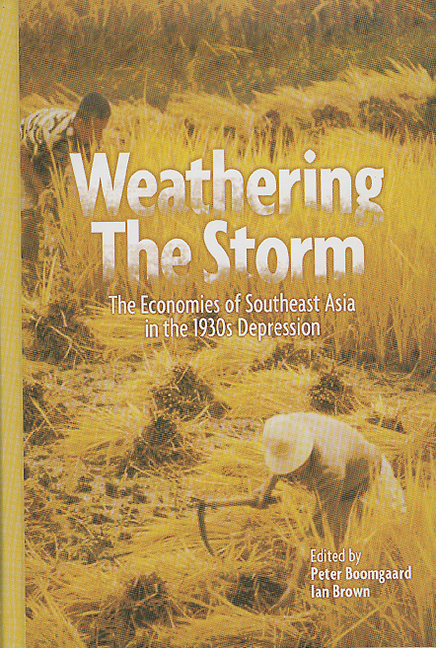Book contents
- Frontmatter
- Contents
- List of Tables
- List of Figures
- Acknowledgements
- List of Contributors
- 1 The Economies of Southeast Asia in the 1930s Depression: An Introduction
- PART I MATERIAL CONDITIONS
- 2 Surviving the Slump: Developments in Real Income During the Depression of the 1930s in Indonesia, Particularly Java
- 3 The Philippines in the Great Depression: A Geography of Pain
- 4 Uneven Impact and Regional Responses: The Philippines in the 1930s Depression
- 5 Material Conditions in Rural Lower Burma During the Economic Crisis of the Early 1930s: What the Cotton Textile Import Figures Reveal
- PART II AGRICULTURAL STRATEGIES
- PART III TRADING COMMUNITIES
- PART IV THE STATE'S RESPONSE
- Index
4 - Uneven Impact and Regional Responses: The Philippines in the 1930s Depression
from PART I - MATERIAL CONDITIONS
Published online by Cambridge University Press: 21 October 2015
- Frontmatter
- Contents
- List of Tables
- List of Figures
- Acknowledgements
- List of Contributors
- 1 The Economies of Southeast Asia in the 1930s Depression: An Introduction
- PART I MATERIAL CONDITIONS
- 2 Surviving the Slump: Developments in Real Income During the Depression of the 1930s in Indonesia, Particularly Java
- 3 The Philippines in the Great Depression: A Geography of Pain
- 4 Uneven Impact and Regional Responses: The Philippines in the 1930s Depression
- 5 Material Conditions in Rural Lower Burma During the Economic Crisis of the Early 1930s: What the Cotton Textile Import Figures Reveal
- PART II AGRICULTURAL STRATEGIES
- PART III TRADING COMMUNITIES
- PART IV THE STATE'S RESPONSE
- Index
Summary
The impact of the 1930s depression on the Philippines shows a mixed picture, differing according to region and social class. Most probably the Philippines as a whole suffered less than neighbouring countries. Comparative figures show that for the years 1934 to 1938, consumption levels in the Philippines were the highest in Asia outside Japan. However, national averages do not tell the whole story. Declining prices hit agrarian commodities unevenly, and as each commodity was concentrated in a particular ecological region, the regional impact of the crisis was uneven.
The economic decline in the advanced capitalist countries was transmitted to the tropical colonies through four mechanisms — the decline in trade, the change in relative prices in favour of the advanced countries, the decline in capital flows to the colonies, and finally a steep decline in the world price level. The Philippines was affected by all these mechanisms, but less severely than some of its neighbours, because its status as a colony and trading partner of the United States provided it with a number of privileges. Although the country could not escape from price declines, some of its export commodities found a protected market in the United States, enabling it to maintain export volumes and (in the case of sugar) its price level.
Trade between the Philippines and the United States had increased very considerably over the years. The Payne-Aldrich Tariff Act of 1909 and the Underwood Tariff Act of 1913 had instituted reciprocal free trade between the two countries. When the depression hit the United States, the American Government adopted various trade restrictions. The Smoot-Hawley Tariff Act of 1930 substantially increased the import duty on Cuban sugar, but not on Philippine sugar. The Jones-Costigan Act of 1934 applied quotas on sugar imports into the United States, but the Philippines received a much more favourable quota than did Cuba.
- Type
- Chapter
- Information
- Weathering the StormThe Economies of Southeast Asia in the 1930s Depression, pp. 83 - 108Publisher: ISEAS–Yusof Ishak InstitutePrint publication year: 2001



